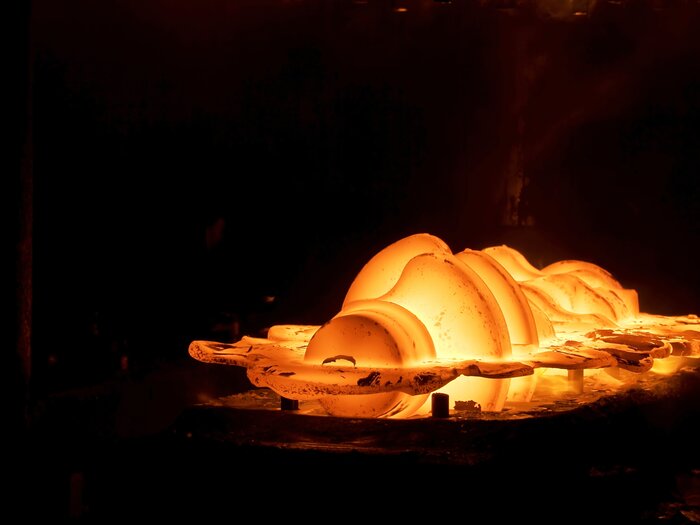Maximálne rozmery: Ø 800 mm x hĺbka 2 000 mm
Pobočky
Pobočky a predajní partneri RÜBIG po celom svete

Predchádzajúce kroky spracovania, ako je valcovanie, ohýbanie, kovanie atď., môžu viesť k zníženiu kvality obrobku. Žíhaním sa dajú tieto účinky zvrátiť.
V spoločnosti RÜBIG ponúkame našim zákazníkom rôzne postupy žíhania na obnovenie požadovaných vlastností obrobkov.
Procesy žíhania sa môžu vykonávať v ochrannej atmosfére alebo vo vákuu. Naše procesy žíhania ponúkame pre širokú škálu materiálov (napr. oceľ, hliník, titán, zliatiny medi, zliatiny na báze niklu, ...).
Prehľad procesu žíhania
Žíhanie na zníženie napätia
Žíhanie na zníženie napätia je špeciálne tepelné spracovanie v ochrannej atmosfére, ktoré znižuje mechanické a tepelné napätia (zvyškové napätia), ako aj kalenie bez výraznej zmeny mikroštruktúry. Žíhanie na uvoľnenie napätia je nevyhnutné pri zložito tvarovaných súčiastkach s rizikom deformácie a pri zložitých geometriách po hrubom obrábaní.
Teplota žíhania na uvoľnenie napätia pre väčšinu ocelí je v rozsahu 450 °C až 650 °C. Trvanie žíhania trvá niekoľko hodín a závisí od teploty žíhania a veľkosti obrobku (prierezu). Aby sa predišlo novým tepelným napätiam, je dôležité, aby sa komponenty po uplynutí doby držania ochladzovali pomaly.
Žíhanie na zníženie napätia sa môže vo všeobecnosti vykonávať na kovových materiáloch, ako sú zliatiny hliníka, medi, mosadze, titánu a titánových zliatin. Môže sa vykonávať podľa vlastných výrobných noriem zákazníka alebo v súlade s časovo-teplotnými špecifikáciami výrobcu.
Žíhanie na mäkko a žíhanie GKZ
Naše procesy žíhanie na mäkko a žíhania GKZ sú špeciálne tepelné úpravy v ochrannej atmosfére, ktorých cieľom je tvorba karbidov a zníženie tvrdosti. Toto žíhanie zlepšuje obrobiteľnosť a tvárniteľnosť (za studena) obrobkov a optimálne pripravuje mikroštruktúru na ďalšie tepelné spracovanie, ako je kalenie.
Teplota žíhania na mäkko je zvyčajne medzi 650 °C a 800 °C a žíhanie trvá niekoľko hodín (2 - 4 hodiny udržiavacieho času). Presné trvanie závisí od teploty žíhania a veľkosti obrobku.
Normalizačné žíhanie
Normalizačné žíhanie (známa aj ako normalizácia) je špeciálne tepelné spracovanie v ochrannej atmosfére, ktorým sa dosiahne rovnomerná mikroštruktúra s jemným zrnom . Táto tzv. normalizovaná mikroštruktúra môže byť buď prechodným stavom pred ďalšími tepelnými úpravami, ako je kalenie, alebo konečným prevádzkovým stavom súčiastky s vysokou pevnosťou a húževnatosťou.
Normalizácia môže pomôcť znížiť valivú štruktúru, znížiť sklon ku krehkému lomu, zjednotiť štruktúru výkovku, odstrániť hrubú štruktúru odliatku, zlepšiť pevnosť a húževnatosť súčiastky a zvýšiť pevnosť a húževnatosť súčiastky.zlepšiť pevnosť a húževnatosť a dosiahnuť jednotnú mikroštruktúru vo zvarovom kove, tepelne ovplyvnenej zóne (HAZ) a základnom materiáli.
Na dosiahnutie požadovaných vlastností má rozhodujúci význam optimalizácia žíhania v spolupráci s našimi zákazníkmi. V spoločnosti RÜBIG sa preto normalizačné žíhanie vykonáva len po podrobnej konzultácii s našimi zákazníkmi.
Rozpúšťacie žíhanie
Rozpúšťacie žíhanie, známe aj ako homogenizácia, je dôležitým tepelným spracovaním austenitických aj duplexných ocelí. Cieľom tohto spracovania je rovnomerné rozloženie karbidových zrazenín a iných fáz tuhého roztoku v mikroštruktúre ich uvedením do roztoku. Následné rýchle ochladenie zabraňuje opätovnému vyzrážaniu. Tým sa nielen zvyšuje odolnosť proti korózii, ale dosahuje sa aj rovnomerné rozloženie legujúcich prvkov v materiáli.
Vysoká teplota spracovania, zvyčajne v rozsahu 950 °C až 1 200 °C, umožňuje korigovať a kompenzovať deformácie za studena spôsobené obrábaním (napr. hlbokým ťahaním) alebo štrukturálne zmeny a napätia spôsobené tepelnými procesmi (napr. zváraním) (rekryštalizácia).
Žíhanie bez remanencie (magnetické konečné žíhanie)
Bezremanentné žíhanie, známe aj ako konečné magnetické žíhanie, je špecializovaný proces tepelného spracovania, ktorého cieľom je odstrániť magnetické vlastnosti ocele a iných kovových materiálov. Táto technika je obzvlášť vhodná pre aplikácie, kde je magnetická remanencia - zostávajúca magnetizácia po odstránení vonkajšieho magnetického poľa - nežiadúca. Prostredníctvom starostlivo riadených cyklov zahrievania a chladenia možno materiály zbaviť remanencie, čo z nich robí ideálne materiály na použitie v elektrotechnike, strojárstve a iných odvetviach, kde sa vyžadujú materiály bez magnetického rušenia. Žíhanie bez remanencie je preto základným procesom na zabezpečenie funkčnosti a spoľahlivosti komponentov v magneticky citlivých aplikáciách."
Ďalšie spôsoby žíhania
Ďalšie spôsoby žíhania, ako je difúzne žíhanie, FP žíhanie (BG žíhanie), rekryštalizačné žíhanie, perlitové žíhanie a feritové žíhanie, sa ponúkajú len po podrobnej konzultácii.
Na žiadosť zákazníka je možné vykonať prispôsobené procesy.

Máte nejaké otázky?
RÜBIG firma pre tepelné spracovanie kombinuje najmodernejšiu technológiu a hlboké priemyselné znalosti s cieľom optimalizovať povrchovú úpravu vašich produktov z ocele.
DI David Unterberger
Riaditeľ predaja - Technológia spevňovania





